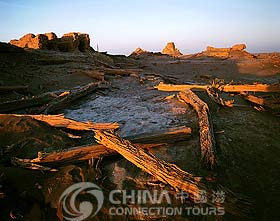 To the east of the Niya ruins is another world-famous city ruins that of the Loulan Kingdom, which was swallowed up by the shifting sands of the Taklamakan Desert some 1,400 years ago. On the west bank of Lop Nur Lake, which is now a lake of sand instead of water, the Ancient City of Loulan was founded in the 2nd century BC in an oasis with rich water network. However it suddenly waned into the history after about 800 years flourish. Records of the Loulan Kingdom abound in major historical works in both China and the West of over 1600 years ago. Founded in the second century BC, Loulan was a sprawling kingdom of 360 thousand square kilometers whose domain bordered Dunhuang in the east and Niya city in the west. It had a population of over 14,000 people,and as a key traffic hub on the ancient Silk Road, it served as an important trading center between China and the West, welcoming streams of camel trains loaded with exotic goods from many parts of the world. Many of the visitors and caravans were from the Mediterranean region. However it simply vanished, the only recognizable structures are a pagoda which is the largest structure in the ruins, and a seems-to-be office which still has painted timber traces.
To the east of the Niya ruins is another world-famous city ruins that of the Loulan Kingdom, which was swallowed up by the shifting sands of the Taklamakan Desert some 1,400 years ago. On the west bank of Lop Nur Lake, which is now a lake of sand instead of water, the Ancient City of Loulan was founded in the 2nd century BC in an oasis with rich water network. However it suddenly waned into the history after about 800 years flourish. Records of the Loulan Kingdom abound in major historical works in both China and the West of over 1600 years ago. Founded in the second century BC, Loulan was a sprawling kingdom of 360 thousand square kilometers whose domain bordered Dunhuang in the east and Niya city in the west. It had a population of over 14,000 people,and as a key traffic hub on the ancient Silk Road, it served as an important trading center between China and the West, welcoming streams of camel trains loaded with exotic goods from many parts of the world. Many of the visitors and caravans were from the Mediterranean region. However it simply vanished, the only recognizable structures are a pagoda which is the largest structure in the ruins, and a seems-to-be office which still has painted timber traces.
Then at the turn of the 20th century, the lost kingdom was brought into the light again when a Swedish adventurer named Sven Hedin was exploring the Lake Lop Nur area. Hedin accidentally discovered the ruins of the kingdom buried under the yellow sands of the Taklamakan Desert. The discovery startled the world. The city is in the shape of Irregular Square, with the east city wall of 333 meters, the south wall of 329 meters, and the west and north walls respectively 327 meters.
Archeologists believe there was once a water tunnel running through the city and dividing it into two functional parts. Large amounts of potsherds, wood pieces, coins, jewelries and wood slip documents are listed in the archaeological finds, which provide us many clues of the ancient city. The most eye-catching architecture is a wooden Buddhist pagoda located in the east of the city ruins. This octagonal-shaped pagoda is ten meters in height, with a square base and a round top.
 In recent years, there were greater finds around the ruins. Archaeologists found the graveyard which was lost after its previous discovery. On a giant sand dune, there are densely distributed wood stakes which are apparently arrayed around a column like genital. Hundreds of cimbalom coffins scatter around, while most of them are broken, with mummies lying around. Among one of them, one coffin contains a well-preserved mummy who is female with Caucasian features. Archaeologists also found colorfully painted and crosshatched coffins, remaining new. A real size wood statue with clear female characteristics, though cracking and crippled, proves that early Loulan people could produce fairly good artistic pieces. The graveyard is, archaeologists believe, a holy place where early Loulan people prayed for strong reproductive ability.
In recent years, there were greater finds around the ruins. Archaeologists found the graveyard which was lost after its previous discovery. On a giant sand dune, there are densely distributed wood stakes which are apparently arrayed around a column like genital. Hundreds of cimbalom coffins scatter around, while most of them are broken, with mummies lying around. Among one of them, one coffin contains a well-preserved mummy who is female with Caucasian features. Archaeologists also found colorfully painted and crosshatched coffins, remaining new. A real size wood statue with clear female characteristics, though cracking and crippled, proves that early Loulan people could produce fairly good artistic pieces. The graveyard is, archaeologists believe, a holy place where early Loulan people prayed for strong reproductive ability.
The discovery may explain why the active and flourishing oasis vanished. It is discovered early Loulan people preferred Sun Tomb, consisting of seven circles of logs, which become thicker and thicker from the center to the outer circle radiating like the sun. The unique and spectacular burying form prevailed and undermined Loulan's existence. Large amount of trees was consumed before Loulan people realized and legislated to control wood consumption and to protect woods and trees. However it seemed to be late and the city swallowed by the fierce desert.
Today, archaeologists and historians worldwide are still working hard to resolve the continuing mystery of this ancient kingdom. And, without doubt, the ruined city of the Loulan Kingdom is also a great place for tourists interested in both history and adventure to explore. However, be warned: the journey into the unforgiving wastes of the Taklamakan Desert is not for the faint of heart.

